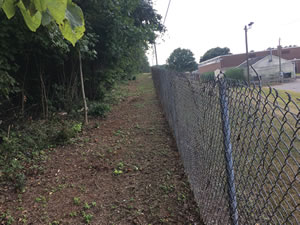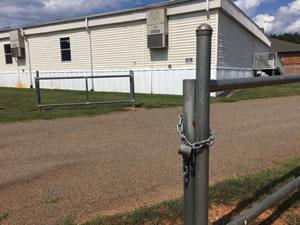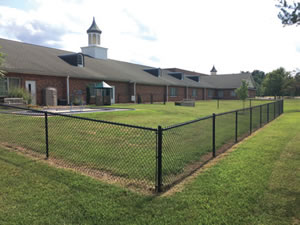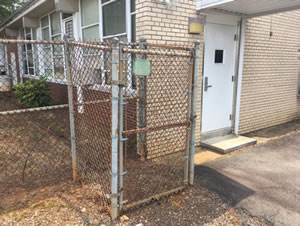Removing Barriers

PHOTO © ANDREW LAROWE
Robert Frost said, “Never take down a fence until you know why it was put up.” Have you ever wondered about the purpose of a particular section of fencing at a school? The question might be answered by going all the way back to the original design of the campus. At the time of construction there may have been code requirements or local ordinances that required the project designer to specify fencing or other types of barriers. There may have been district level safety and security standards that were included in the design specifications. Over the span of time as codes, ordinances and district requirements change, school districts introduce additional fencing and barriers, often without removing or upgrading the original fencing. Other groups may also become involved with the addition of even more fencing in response to specific needs such as PTSA school improvement projects. Ultimately, an older school campus can become cluttered with many different types of barriers that may or may not be serving the original purpose. It may be time to assess current requirements against existing conditions and develop a comprehensive fencing management plan.

PHOTO © ANDREW LAROWE
There are a variety of circumstances that necessitate barriers on school grounds. Security and safety for school children are always at the top of the priority list. After the tragic events at Columbine and Sandy Hook, attempts to control campus accessibility focused a great deal of attention on fencing and other types of barriers. However, simply adding more fencing may not produce the desired effect. With the exception of certain urban environments, it is unrealistic to fully restrict daytime access to schools by installing perimeter fencing. To do so requires a significant investment in materials and maintenance, not to mention dealing with open access for buses, parents, staff and invited guests. Eliminating access to the school population by use of fencing is in most instances problematic and comes with significant costs.

PHOTO © ANDREW LAROWE
Securing the campus during the offhours to prevent theft or vandalism is another matter. Steve Shelton, president of Fence Builders in Winston-Salem, N.C., has provided fencing services to school districts for over 40 years. Shelton claims, “most people breaking into school property do not climb over security fences, they cut a hole and walk right through.” There is a delicate balance between providing safe and secure school facilities and allowing schools to look like prisons. It is clear that fencing and barriers are necessary on school campuses, however; district leaders can make clear choices regarding the type of fence systems used and the message they send. Chain link fencing should be installed with a top rail and the upper edge of the fabric should always terminate in the closed “knuckle” style rather than the sharp pointed “twist” style. Avoid the three strand barb wire arms if at all possible and under no circumstances should concertina, or coiled razor wire ever be installed on a school campus! It may be appropriate for incarceration facilities or border defense but too dangerous to be in the proximity of children and a sure-fire way to make a school look like a penitentiary.

PHOTO © ANDREW LAROWE
One of the clearest reasons for fencing on school grounds is to separate children from dangerous areas such as those with vehicular traffic, mechanical equipment, or accessible heights that present a potential fall hazard. A properly designed fence separating a playground from a busy highway immediately relieves teacher’s concerns of a child chasing a ball into oncoming traffic. In as much as safety barriers can be overlooked on school grounds, sometimes they may be overdone or become obsolete. It is not uncommon to see a fenced in area near a classroom that used to contain kindergarten playground equipment which, has long since been removed as use of the facility changed. If a fence is no longer needed, take it down. It will be one less obstacle to contend with in the event of an emergency.

PHOTO © ANDREW LAROWE
Some fences and barriers exist purely to define property boundaries, especially if there is a specific need to delineate the school campus from adjoining residential or commercial properties. Unless there is an access issue as well, this is an area where schools could possibly eliminate unnecessary and unsightly fencing. A start would be to contact the neighbor to gain their perspective. If property ownership has changed or the circumstances that occurred in the first place or no longer present, perhaps they would have no objection to the fence being removed. If the boundary needs to be identified, consider landscaping options. In many cases, if a fence is in place solely to mark a property line it may be unnecessary. Removing it could reduce workload for grounds maintenance and provide a less cluttered view of the school campus.

PHOTO © ANDREW LAROWE
Fence management. There are a variety of reasons why it may be necessary to place fencing on school grounds. But as time goes by, these structures may become obsolete, begin to deteriorate, or create a hazardous condition. Failing to maintain them or remove them when they are no longer necessary may send an unattractive message to the community regarding the condition of their schools.
Many schools utilize swing gates to limit vehicular access during non-occupied hours. These gates are typically constructed with steel pipe, hinged to vertical posts on each side of the road and secured with chain and padlocks when closed. They present a serious safety threat when left unsecured in the open position as they may be subject to a sudden gust of wind, moving the gate into traffic flow without warning. Swing gates must include a “hold back” system that assures the gate will not swing freely when open. Some districts may adopt a protocol that requires swing gates to always be secured and padlocked whether they are in the open or closed position.
In many areas, fencing provides the perfect structure for invasive vegetation. Just as an old rusty broken fence can make a school campus appear rundown, one overgrown with vines and weeds communicates a lack of care. A common error when installing fencing is placing it too close to the property line limiting accessibility for mowing or cutting underbrush. When possible, maintain a minimum width on the outside of the fence for standard mowing equipment. A regular maintenance program of spraying weed control along the bottom edge of the fence line each spring will also help prevent unwanted vegetation.

PHOTO © ANDREW LAROWE
When preparing a fencing management plan for new or existing schools, CPTED (Crime Prevention Through Environmental Design) can be a great resource, particularly when attempting to reduce obsolete fencing. Their guidance frequently discourages an overdependence on fencing. Use of bollards, post and chain, large rocks and natural landscape can enhance the overall appearance of the campus while discouraging access to vulnerable areas. Beware of unintended consequences related to some of these alternatives. For instance, stringing a cable between posts may be effective to limit vehicle access, although it could present a serious hazard for bicyclist or pedestrians. Vehicle barriers should include well placed pedestrian pathways that are easy to identify.
Clearly, fencing and other types of barriers are an essential tool for facility professionals and administrators to keep school campuses safe and secure. Unfortunately, as time goes by, these structures may become obsolete, begin to deteriorate, or create a hazardous condition. Failing to remove them when they are no longer necessary, or to maintain them properly may also send an unattractive message to the community regarding the condition of their schools.
This article originally appeared in the issue of .